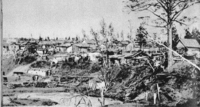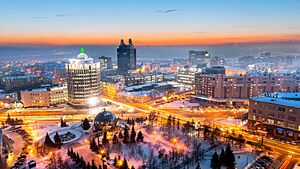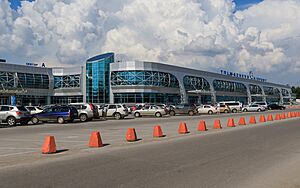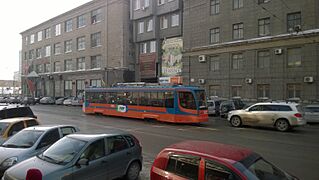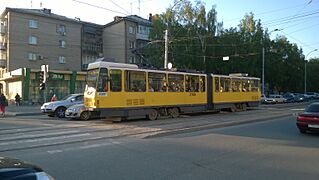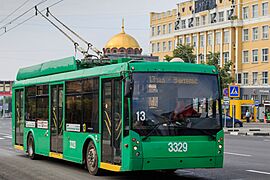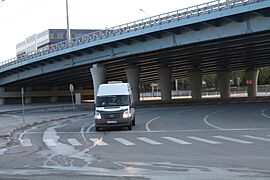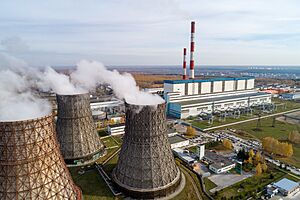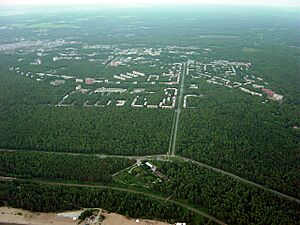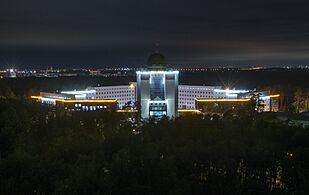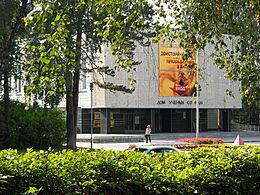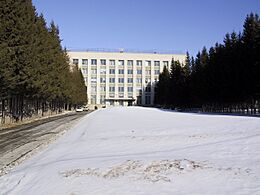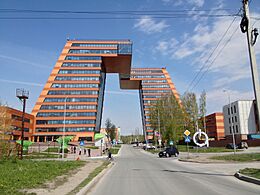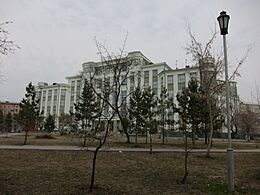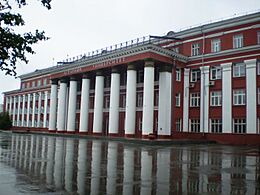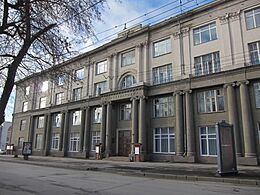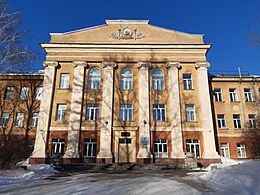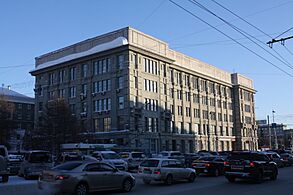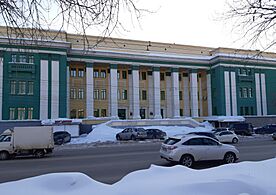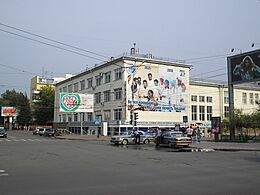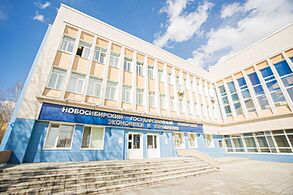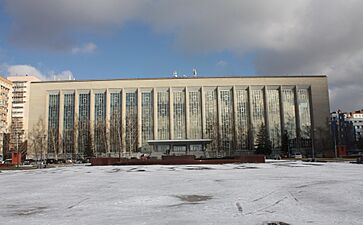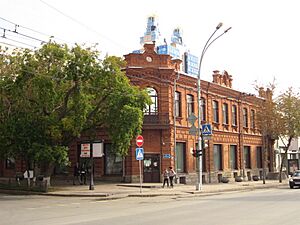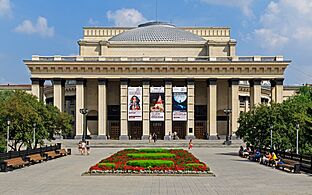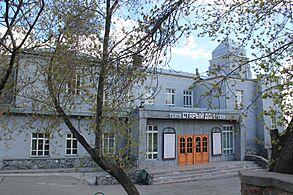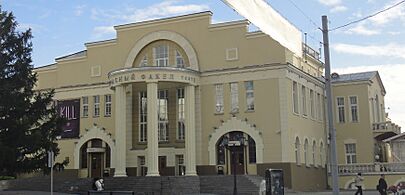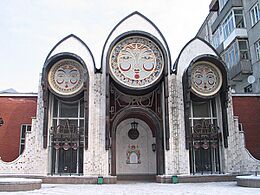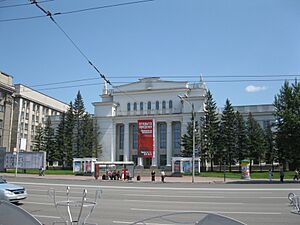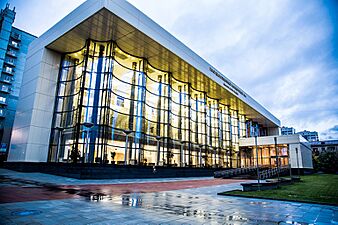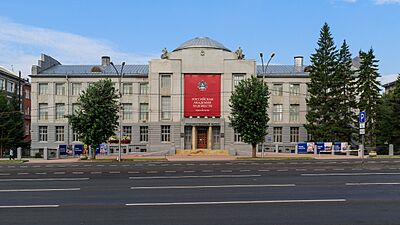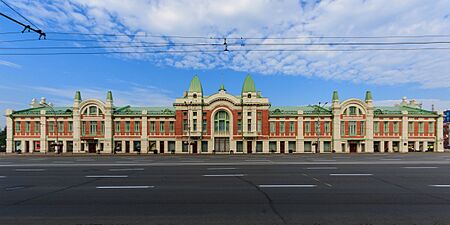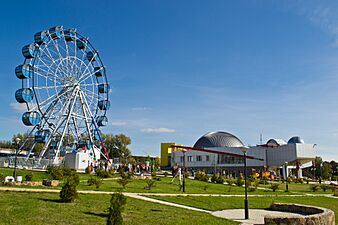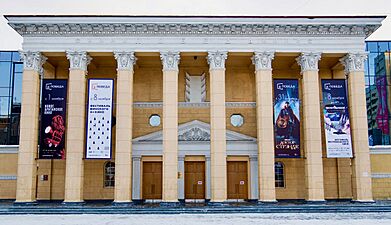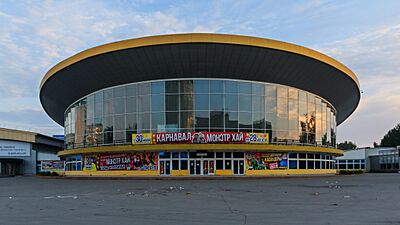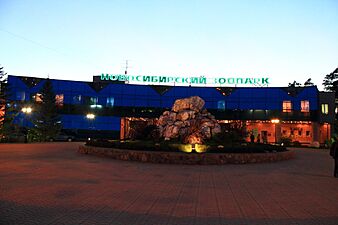Novosibirsk facts for kids
Quick facts for kids Novosibirsk (English)Новосибирск (Russian) |
|
|---|---|
| - City - | |
| [[File:
Novosibirsk Opera and Ballet Theatre
Novosibirsk railway station
Novosibirsk State Circus
City Trade House
|
|
|
|
|
| City Day | Last Sunday of June |
| Administrative status | |
| Country | Russia |
| Federal subject | Novosibirsk Oblast |
| Municipal status | |
| Urban okrug | Novosibirsk Urban Okrug |
| Head (Mayor) | Maxim Kudryavtsev |
| Representative body | Council of Deputies |
| Statistics | |
| Area | 502.7 km2 (194.1 sq mi) |
| Population (2010 Census, preliminary) |
1,473,754 inhabitants |
| - Rank in 2010 | 3rd |
| Population (January 2015 est.) | 1,567,087 inhabitants |
| Density | 2,932/km2 (7,594/sq mi) |
| Time zone | OMST (UTC+07:00) |
| Founded | 1893 |
| City status since | January 10, 1904 [O.S. December 28, 1903] |
| Postal code(s) |
List
630000, 630001, 630003–630005, 630007–630011, 630015, 630017, 630019, 630020, 630022, 630024, 630025, 630027–630030, 630032–630037, 630039–630041, 630045–630049, 630051, 630052, 630054–630061, 630063, 630064, 630066, 630068, 630071, 630073, 630075, 630077–630080, 630082–630084, 630087–630092, 630095–630100, 630102, 630105–630112, 630114, 630116, 630117, 630119–630121, 630123, 630124, 630126, 630128, 630129, 630132, 630133, 630136, 630200, 630201, 630700, 630880, 630885, 630890, 630899–630901, 630910, 630920–630926, 630970–630978, 630980–630983, 630985, 630988, 630989, 630991–630993, 901026, 901036, 901073, 901076, 901078, 901095, 901243, 901245, 901246, 991214 |
| Dialing code(s) | +7 383 |
| Official website: http://www.novo-sibirsk.ru | |
Novosibirsk is the biggest city and important center of Novosibirsk Oblast and the Siberian Federal District in Russia. It is the most populated city in Siberia and the third-largest city in Russia. Only Moscow and Saint Petersburg have more people. It is also the largest city in the Asian part of Russia. Novosibirsk is in southwestern Siberia, located on the banks of the Ob River.
The city was started in 1893 where the Trans-Siberian Railway was planned to cross the Ob River. A bridge was built there. It was first called Novonikolayevsk (meaning "New Nicholas") to honor Emperor Nicholas II. The city grew very fast and became a major center for transport, trade, and industry. After the Russian Civil War, it recovered and got its current name, Novosibirsk ("New Siberia"), in 1926. During the time of Joseph Stalin, Novosibirsk became one of Siberia's biggest industrial cities. When World War II started, many factories from western Russia moved to Novosibirsk.
Novosibirsk has many famous places. These include the Alexander Nevsky Cathedral, the Novosibirsk Opera and Ballet Theatre, and the Novosibirsk Zoo. The city's main airport is Tolmachevo Airport, which is the busiest in Siberia.
Contents
- History of Novosibirsk
- City Administration and Districts
- Population and People
- Nature and Environment
- Geography and Climate
- Transportation in Novosibirsk
- Economy and Industry
- City Government
- Sports in Novosibirsk
- Music and Arts
- Education in Novosibirsk
- Culture and Entertainment
- Botanical Gardens
- Sister Cities
- Famous People from Novosibirsk
- See also
History of Novosibirsk
How Novosibirsk Started
Novosibirsk was founded on April 30, 1893. It was built on the right side of the Ob River. This spot was chosen because a bridge for the Trans-Siberian Railway was going to be built there. In 1895, it was named Novonikolayevsk. This name honored both Saint Nicholas and the new Tsar, Nicholas II.
The city replaced an older village called Bolshoye Krivoshchyokovo. That village was on the other side of the Ob River. The new bridge was finished in 1897. This made Novonikolayevsk an important transport hub. The city became even more important when the Turkestan–Siberia Railway was completed in the early 1900s. This new railway connected Novonikolayevsk directly to Central Asia.
Early Growth and Development
When the bridge opened, Novonikolayevsk had about 7,800 people. The city grew very quickly. Its first bank opened in 1906, and by 1915, there were five banks. In 1907, Novonikolayevsk had over 47,000 people and was officially made a town. This gave it the right to govern itself.
Before the October Revolution, the city's population reached 80,000. It had strong economic growth and became a major trade and industry center in Siberia. The city developed industries for processing farm products. It also had a power station, an iron factory, and many businesses. By 1917, Novonikolayevsk had seven Orthodox churches and one Roman Catholic church. There were also cinemas, schools, and a teaching college. In 1913, it was one of the first places in Russia to make primary education required for all children.
Challenges and Recovery
The Russian Civil War (1917–1923) caused many problems for the city. Diseases like typhus and cholera killed thousands of people. The Ob River Bridge was destroyed during the war. For the first time, the population of Novonikolayevsk started to shrink.
The city was taken over by the Soviet Workers' and Soldiers' Deputies in December 1917. In May 1918, the Czechoslovak Legion and the White Guards captured Novonikolayevsk. But the Red Army took the city back in 1919 and held it for the rest of the war.
Novonikolayevsk began to rebuild in 1921. This was during Lenin's New Economic Policy. The city was part of Tomsk Governorate and later became the center of Novonikolayevsk Governorate. On September 12, 1926, the city got its current name, Novosibirsk. This means "New Siberian town" in Russian.
Industrialization and World War II
During Joseph Stalin's plan to industrialize the country, Novosibirsk became a huge industrial center in Siberia. Many large factories were built. These included the 'Sibkombain' plant, which made heavy mining equipment. Other factories for metal processing, food processing, and a new power station were also built.
The great Soviet famine of 1932–33 caused over 170,000 people from rural areas to come to Novosibirsk looking for food and safety. They lived in simple shelters on the edge of the city. Because of its fast growth and industry, people in the US media called Novosibirsk the "Chicago of Siberia".
Tram lines were built in 1934. By then, the city's population had grown to 287,000, making it the largest city in Siberia. In 1935, a new bridge, the Kommunalny bridge, replaced the old road bridge over the Ob River.
Between 1941 and 1942, during World War II, the Soviet government moved over 50 large factories from western Russia to Novosibirsk. This was to protect them from being destroyed in the war. The city became a major supply base for the Red Army. During this time, Novosibirsk also took in more than 140,000 refugees.
Post-War Development and Science City
The city's rapid growth led to the building of a hydroelectric power station in the 1950s. This station created a huge water reservoir called the Ob Sea. Building the station flooded large areas of farmland and pine forests. It also made the winds stronger, which increased soil erosion.
In the 1950s, the Soviet government decided to build a science research center in Novosibirsk. In 1957, the Akademgorodok complex was built about 30 kilometers south of the city center. This "science town" is home to the Siberian Division of the Russian Academy of Sciences. It has over 35 research institutes and universities, including Novosibirsk State University. Akademgorodok has its own facilities but is managed by Novosibirsk.
On September 2, 1962, Novosibirsk's population reached one million. It was the youngest city in the world to reach this size, doing so in less than 70 years. In 1965, there was a famous aerial stunt where a pilot flew his MiG-17 jet under the October Bridge. Work on the Novosibirsk Metro Transit System began in 1979, and the first line opened in 1985.
On August 1, 2008, Novosibirsk was in the center of a solar eclipse. The eclipse lasted for 2 minutes and 20 seconds.
City Administration and Districts
Novosibirsk is the main administrative center of the Novosibirsk Oblast. This means it's where the regional government is located. It also serves as the administrative center for Novosibirsky District, even though it's not officially part of that district. The city of Novosibirsk is a special administrative unit, similar to a district.
For local government, the City of Novosibirsk is known as the Novosibirsk Urban Okrug.
City Districts of Novosibirsk
Novosibirsk is divided into several smaller areas called city districts. These help manage the city better.
- Dzerzhinsky
- Kalininsky
- Kirovsky
- Leninsky
- Oktyabrsky
- Pervomaysky
- Sovetsky
- Tsentralny
- Zayeltsovsky
- Zheleznodorozhny
Population and People
| Historical population | ||
|---|---|---|
| Year | Pop. | ±% |
| 1897 | 8,000 | — |
| 1926 | 117,863 | +1373.3% |
| 1939 | 405,297 | +243.9% |
| 1959 | 885,045 | +118.4% |
| 1970 | 1,160,963 | +31.2% |
| 1979 | 1,312,480 | +13.1% |
| 1989 | 1,436,516 | +9.5% |
| 2002 | 1,425,508 | −0.8% |
| 2010 | 1,473,754 | +3.4% |
| 2021 | 1,633,595 | +10.8% |
| Source: Census data | ||
In 2021, the population of Novosibirsk was 1,633,595 people. This was more than in 2010, when the city had 1,473,754 residents.
People from over eighty different ethnic groups and nationalities live in Novosibirsk. The largest groups are Russian, Tajik, Tatar, Uzbek, Ukrainian, and Kyrgyz.
| Ethnic group | Population | Percentage |
|---|---|---|
| Russians | 1,161,185 | 93.9% |
| Tajiks | 6,502 | 0.5% |
| Tatars | 6,213 | 0.5% |
| Uzbeks | 5,665 | 0.5% |
| Ukrainians | 5,436 | 0.4% |
| Kyrgyz | 5,421 | 0.4% |
| Other | 45,864 | 3.7% |
Nature and Environment
Plants of Novosibirsk
The most common trees that grow naturally in Novosibirsk are birch, pine, and aspen. You can also find some mountain ash, hawthorn, spruce, and fir trees. Some types of apple, ash, elm, linden, and oak trees from Europe have also been successfully planted here.
Geography and Climate
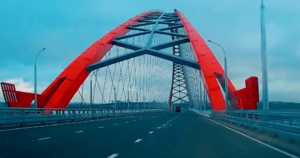
City Layout and Bridges
The city's modern design is based on plans made after the revolution. Before 1917, Novonikolayevsk did not have one clear city center. Important buildings like the railway offices, the main cathedral, and government offices were spread out. This changed after the revolution. The Lenin House was built in 1925 on Krasny Prospekt, the main avenue.
Novosibirsk has three road bridges, two railway bridges, and one metro bridge over the Ob River. The dam of the Novosibirsk Hydroelectric Station also has a road on it.
Where Novosibirsk is Located
The city is on the banks of the Ob River in the West Siberian Plain. The southern part of the city touches the Novosibirsk Reservoir. This reservoir was created by the dam of the Novosibirsk Hydroelectric Station.
Nearby major cities include Omsk, Barnaul, Kemerovo, and Tomsk.
Novosibirsk's Climate
Novosibirsk has a typical Siberian climate. Winters are dry and very cold. This is because there is no ocean nearby and no tall mountains to block cold Arctic winds. Novosibirsk is one of the farthest major cities from an ocean in the world.
The climate is humid continental (Köppen Dfb). This means it has warm summers and very cold winters. Snow falls often in winter, but usually not a lot at once. Summer temperatures are usually between +15°C and +26°C. Winter temperatures are typically between -20°C and -12°C. However, winter can get as cold as -30°C to -35°C, and summer can reach +30°C to +35°C. The biggest difference between the highest and lowest recorded temperatures is 82°C.
Visitors from warmer countries might find Novosibirsk's winter extremely cold. But it is not as severe as places further east in Siberia. For example, it's less cold than Spassk-Dalny, which is further south. Its overall temperatures are very similar to Winnipeg, Canada. Very cold temperatures below -40°C do not happen every year.
| Climate data for Novosibirsk (1991–2020, extremes 1930–present) | |||||||||||||
|---|---|---|---|---|---|---|---|---|---|---|---|---|---|
| Month | Jan | Feb | Mar | Apr | May | Jun | Jul | Aug | Sep | Oct | Nov | Dec | Year |
| Record high °C (°F) | 4.1 (39.4) |
5.1 (41.2) |
14.4 (57.9) |
30.7 (87.3) |
36.1 (97.0) |
37.3 (99.1) |
36.4 (97.5) |
35.7 (96.3) |
33.2 (91.8) |
23.8 (74.8) |
11.7 (53.1) |
4.8 (40.6) |
37.3 (99.1) |
| Mean daily maximum °C (°F) | −12.6 (9.3) |
−9.2 (15.4) |
−1.3 (29.7) |
9.6 (49.3) |
18.9 (66.0) |
23.8 (74.8) |
25.4 (77.7) |
23.1 (73.6) |
16.1 (61.0) |
7.9 (46.2) |
−3.4 (25.9) |
−9.9 (14.2) |
7.4 (45.3) |
| Daily mean °C (°F) | −17.0 (1.4) |
−14.4 (6.1) |
−6.8 (19.8) |
3.6 (38.5) |
11.9 (53.4) |
17.6 (63.7) |
19.5 (67.1) |
16.9 (62.4) |
10.3 (50.5) |
3.3 (37.9) |
−6.8 (19.8) |
−13.9 (7.0) |
2.0 (35.6) |
| Mean daily minimum °C (°F) | −21.2 (−6.2) |
−19.1 (−2.4) |
−11.9 (10.6) |
−1.4 (29.5) |
5.7 (42.3) |
11.7 (53.1) |
13.9 (57.0) |
11.5 (52.7) |
5.7 (42.3) |
−0.2 (31.6) |
−10.1 (13.8) |
−18 (0) |
−2.8 (27.0) |
| Record low °C (°F) | −46.2 (−51.2) |
−46.3 (−51.3) |
−36.4 (−33.5) |
−29 (−20) |
−8.6 (16.5) |
−2.0 (28.4) |
3.9 (39.0) |
0.2 (32.4) |
−6.9 (19.6) |
−26.4 (−15.5) |
−39.6 (−39.3) |
−45.7 (−50.3) |
−46.3 (−51.3) |
| Average precipitation mm (inches) | 25 (1.0) |
18 (0.7) |
20 (0.8) |
24 (0.9) |
37 (1.5) |
55 (2.2) |
68 (2.7) |
58 (2.3) |
46 (1.8) |
43 (1.7) |
39 (1.5) |
36 (1.4) |
469 (18.5) |
| Average rainy days | 1 | 1 | 2 | 8 | 13 | 14 | 14 | 14 | 16 | 12 | 5 | 1 | 101 |
| Average snowy days | 23 | 19 | 15 | 9 | 3 | 0.1 | 0 | 0 | 1 | 11 | 20 | 25 | 126 |
| Average relative humidity (%) | 82 | 81 | 77 | 65 | 58 | 66 | 73 | 75 | 75 | 78 | 83 | 83 | 75 |
| Mean monthly sunshine hours | 67 | 107 | 166 | 213 | 264 | 302 | 304 | 245 | 170 | 100 | 58 | 45 | 2,041 |
| Source 1: Pogoda.ru.net | |||||||||||||
| Source 2: Danish Meteorological Institute (sun, 1931–1960) | |||||||||||||
| Climate data for Novosibirsk (1961–1990) | |||||||||||||
|---|---|---|---|---|---|---|---|---|---|---|---|---|---|
| Month | Jan | Feb | Mar | Apr | May | Jun | Jul | Aug | Sep | Oct | Nov | Dec | Year |
| Mean daily maximum °C (°F) | −12.2 (10.0) |
−10.3 (13.5) |
−2.6 (27.3) |
8.1 (46.6) |
17.5 (63.5) |
24.0 (75.2) |
25.7 (78.3) |
22.2 (72.0) |
16.6 (61.9) |
6.8 (44.2) |
−2.9 (26.8) |
−8.9 (16.0) |
7.0 (44.6) |
| Daily mean °C (°F) | −16.2 (2.8) |
−14.7 (5.5) |
−7.2 (19.0) |
3.2 (37.8) |
11.6 (52.9) |
18.2 (64.8) |
20.2 (68.4) |
17.0 (62.6) |
11.5 (52.7) |
3.4 (38.1) |
−6.0 (21.2) |
−12.7 (9.1) |
2.4 (36.3) |
| Mean daily minimum °C (°F) | −20.1 (−4.2) |
−19.1 (−2.4) |
−11.8 (10.8) |
−1.7 (28.9) |
5.6 (42.1) |
12.3 (54.1) |
14.7 (58.5) |
11.7 (53.1) |
6.4 (43.5) |
0.0 (32.0) |
−9.1 (15.6) |
−16.4 (2.5) |
−2.3 (27.9) |
| Average precipitation mm (inches) | 19 (0.7) |
14 (0.6) |
15 (0.6) |
24 (0.9) |
36 (1.4) |
58 (2.3) |
72 (2.8) |
66 (2.6) |
44 (1.7) |
38 (1.5) |
32 (1.3) |
24 (0.9) |
442 (17.4) |
Transportation in Novosibirsk
Airports and Flights
Novosibirsk is served by Novosibirsk Tolmachevo Airport. This airport connects the city to most large cities in Russia and many countries in Europe and Asia. Tolmachevo is a main base for S7 Airlines.
There used to be a smaller airport for general aviation called Novosibirsk Severny Airport, but it closed in 2012.
Train Travel
Novosibirsk is a major stop on the famous Trans-Siberian Railway. It is also the northern end of the Turkestan–Siberia Railway. The main railway station is Novosibirsk-Glavny station, which means "Main" station. It is in the city center.
There are other railway stations too, like Novosibirsk-Zapadny (Western), Novosibirsk-Vostochny (Eastern), and Novosibirsk-Yuzhny (Southern). All intercity trains stop at these stations. Many regular trains connect Novosibirsk with other Russian cities. International trains also link the city to China, Mongolia, Belarus, and countries in Central Asia.
Bus Services
The old Novosibirsk Bus Station closed in 2020. New bus stations are being built around the city. The first new one opened in 2019. Until more new stations are ready, some bus stops in the city are used for intercity bus services.
Many regular bus routes connect Novosibirsk with most cities in southern Western Siberia and major cities in Central Asia.
River Transport
The Novosibirsk river passenger terminal opened in 1974. A metro station, Rechnoy Vokzal, was built nearby. In 2003, a big fire damaged part of the terminal building.
Today, only two regular passenger boat lines operate. There are also cruises on the Ob river and the Novosibirsk Reservoir. River boats use the Novosibirsk Shipping Canal to move between the river and the reservoir. This canal has a special lock system. The boating season usually runs from late April or early May to late September or early October.
City Public Transportation
Metro System
The Novosibirsk Metro was the fourth metro system built in Russia, after Moscow, Saint Petersburg, and Nizhny Novgorod. It was the first in Siberia. It opened in 1985. As of 2022, it has two lines and 13 stations.
Tram and Trolleybus Systems
The Novosibirsk tram system started in 1934. As of 2022, it has 10 routes. Six routes are on the left bank of the city, and four are on the right bank.
The Novosibirsk trolleybus system began in 1957. As of 2022, it has 14 routes.
Bus Network
The Novosibirsk bus system started in 1923. As of 2022, it has 52 routes for large buses and 17 routes for smaller buses.
Waterbus Routes
As of 2021, the Novosibirsk waterbus system has routes connecting the river passenger terminal to various islands and residential areas. The waterbus season is usually from late April or early May to late September or early October.
Route Taxis (Marshrutkas)
The Novosibirsk fixed-route taxi system uses minibuses. It started in the late 1970s. There are 56 marshrutka routes in Novosibirsk. In recent years, the number of these minibus routes has been decreasing, as they are often replaced by regular bus routes.
-
Waterbus Moskva type on the Ob
-
Ford Transit marshrutka
Economy and Industry
Novosibirsk is a major industrial city. It has 214 large and medium-sized industrial businesses. These businesses create more than two-thirds of all industrial products in the Novosibirsk region. Key industries include aerospace (like Chkalov's Novosibirsk Aircraft Plant), nuclear fuel (Novosibirsk Chemical Concentrates Plant), and power generators (NPO ELSIB). Other important industries are textile machinery, farm machinery, electronics, and metalworking.
In 2008, Novosibirsk was ranked third among Russian cities that are most attractive for businesses. The Rich Family retail company was founded in Novosibirsk in 2002 and still has its main office here.
Many large Russian companies have their main offices in Novosibirsk:
- RATM Holding
- Novosibirsk Aircraft Production Association Plant (NAPO)
- Belon
- Center of Financial Technologies
- NETA IT Company (sells computers and software)
- Parallels IT Company (makes software for virtual computers)
- Inmarko Food Company
- Siberian Food Corporation
- Electro-vacuum plant (a large glass bottle factory)
- NPO NIIIP-NZiK
- 2GIS (a mapping and directory company)
City Government
Until 2023, the head of the city, called the mayor, was chosen by people living in the city. In February 2023, a new law changed this. Now, the mayor of Novosibirsk is chosen by a special committee. On April 16, 2024, Maxim Kudryavtsev was elected as the new mayor.
Sports in Novosibirsk
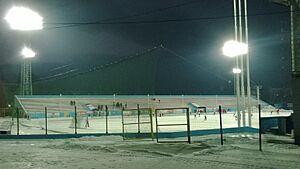
Novosibirsk has many professional sports teams:
| Club | Sport | Founded | Current league | League rank |
Stadium |
|---|---|---|---|---|---|
| FC Novosibirsk | Football | 1936 | Russian Professional Football League | 3rd | Spartak Stadium |
| Sibir Novosibirsk | Ice hockey | 1962 | Kontinental Hockey League | 1st | Ice Sports Palace Sibir |
| Sibselmash Novosibirsk | Bandy | 1937 | Russian Bandy Super League | 1st | Sibselmash Stadium |
| BC Novosibirsk | Basketball | 2011 | Basketball Super League | 2nd | SKK Sever |
| Dynamo-GUVD Novosibirsk | Basketball | 1955 | Women's Basketball Premier League | 1st | SKK Sever |
| Lokomotiv Novosibirsk | Volleyball | 1977 | Volleyball Super League | 1st | Lokomotiv-Arena |
| Sibiryak Novosibirsk | Futsal | 1988 | Futsal Super League | 1st | NSAAA Sports Hall |
Novosibirsk is the hometown of several famous athletes. One is Aleksandr Karelin, a twelve-time world Greco-Roman wrestling champion. He was named the greatest Greco-Roman wrestler of the 20th century.
The city also hosts many national and international Ice Speedway events.
Music and Arts
Novosibirsk is known for its music scene. Many famous classical violinists, like Vadim Repin and Maxim Vengerov, were born here. Other musicians from Novosibirsk include punk singer Yanka Dyagileva and folk singer Pelageya Khanova.
The city has the Novosibirsk State Conservatory, a music school named after the composer Mikhail Glinka. It also has the Novosibirsk State Philharmony, which is home to several orchestras. The Novosibirsk Opera and Ballet Theatre is another important music venue.
Education in Novosibirsk
Novosibirsk has many universities and colleges:
- Novosibirsk State University (1959)
- Novosibirsk State Technical University (1950)
- Novosibirsk State University of Economics and Management (1929)
- Novosibirsk State Agricultural University (1936)
- Novosibirsk State University of Architecture, Design and Arts (1989)
- Novosibirsk State University of Architecture and Civil Engineering (1930)
- Novosibirsk State Medical University (1935)
- Novosibirsk State Pedagogical University (1935)
- Novosibirsk State Theater Institute (1960)
- Novosibirsk State Conservatory named after M.I. Glinka (1956)
- Novosibirsk Higher Military Command School (1967)
- Novosibirsk Military Institute (1971)
- Novosibirsk Institute of the Federal Security Service (1935)
- Siberian State Transport University (1932)
- Siberian State University of Water Transport (1951)
- Siberian State University of Geosystems and Technologies (1933)
- Siberian State University of Telecommunications and Informatics (1953)
- Siberian Institute of Management (1991)
- Siberian Institute of International Relations and Regional Studies (1998)
- Siberian University of Consumer Cooperation (1956)
- Siberian Academy of Finance and Banking (1992)
There are also over 50 vocational schools in Novosibirsk.
Akademgorodok is a special part of Novosibirsk focused on science. It has the Siberian branch of the Russian Academy of Sciences. Novosibirsk State University and the Novosibirsk Higher Military Command School are also located there. Most other universities are in the central part of Novosibirsk.
-
Novosibirsk State Conservatory named after M.I. Glinka
Culture and Entertainment
Libraries for Learning
Novosibirsk has many libraries. Some of the most important ones are:
- State Public Scientific & Technological Library
- Novosibirsk State Regional Scientific Library
- Novosibirsk Regional Special Library for the blind and visually impaired
- Novosibirsk Regional Youth Library
- Novosibirsk Regional Children's Library
Theatres for Performances
The city has many theatres where you can watch plays, operas, and ballets:
- Novosibirsk Opera and Ballet Theatre (1945)
- Novosibirsk Regional Puppet Theatre (1933)
- Novosibirsk State Drama Theatre "Old House" (1933)
- Novosibirsk State Academic Drama Theatre "Red Torch" (1932)
- Novosibirsk Academic Youth Theatre "Globe" (1930)
- Novosibirsk Musical Theatre (1959)
- Novosibirsk City Theatre under the direction of Sergey Afanasiev (1988)
- Novosibirsk Drama Theatre "On the left bank" (1997)
- Novosibirsk Studio Theatre "First Theatre" (2009)
Philharmonic Orchestra
The Novosibirsk State Philharmonic Society was started in 1937. It holds about 60 concerts each month in its halls.
Museums to Explore
There are many museums in Novosibirsk where you can learn about art, history, and more:
- Novosibirsk State Art Museum
- Novosibirsk State Museum of Local Lore
- Museum of Cossacks glory
- Novosibirsk museum of railway equipment
- Museum "Siberian Birch Bark"
- Nicholas Roerich Museum
- Museum of the Sun
- Historical and Architectural Museum in the open air
- Siberian Memorial Art Gallery
Planetariums for Stargazing
Novosibirsk has two planetariums where you can learn about space and stars:
- Small Novosibirsk Planetarium (1952)
- Large Novosibirsk Planetarium (2012) - This one was named the best social building in Russia in 2015.
Fun Places to Visit
Cinemas
There are 16 cinemas in the city, including Cinema Park, which has IMAX and IMAX 3D screens.
Circus
The modern Novosibirsk Circus building was built in 1971.
Novosibirsk Zoo
The Novosibirsk Zoo is famous around the world for its scientific work and is a popular place for visitors.
The zoo has over 11,000 animals from 738 different species. It also takes part in 32 programs to help save endangered animals. Since 2016, the "Dolphinia" oceanography and marine biology center has been part of the zoo. About 1.5 million people visit the zoo every year.
Children's Railway
The Small West Siberian Railway is a special children's railway located in Zayeltsovsky Park.
It has 5 stations: Zayeltsovskiy Park, Razyezd Lokomotiv, Sportivnaya, Razyezd Eltsovskiy, and Zoopark. The railway operates during the summer.
Botanical Gardens
The Central Siberian Botanic Garden is located in Akademgorodok.
Sister Cities
Novosibirsk is twinned with several cities around the world. This means they have special friendly relationships and often share culture and ideas.
 Minneapolis, United States (1989)
Minneapolis, United States (1989) Saint Paul, United States (1989)
Saint Paul, United States (1989) Sapporo, Japan (1990)
Sapporo, Japan (1990) Mianyang, China (1994)
Mianyang, China (1994) Daejeon, South Korea (2001)
Daejeon, South Korea (2001) Varna, Bulgaria (2008)
Varna, Bulgaria (2008) Osh, Kyrgyzstan (2009)
Osh, Kyrgyzstan (2009) Kharkiv, Ukraine (2011)
Kharkiv, Ukraine (2011) Minsk, Belarus (2012)
Minsk, Belarus (2012) Shenyang, China (2013)
Shenyang, China (2013) Yerevan, Armenia (2014)
Yerevan, Armenia (2014) Sevastopol, Ukraine (2014)
Sevastopol, Ukraine (2014) Ulaanbaatar, Mongolia (2015)
Ulaanbaatar, Mongolia (2015) Tiraspol, Moldova (2016)
Tiraspol, Moldova (2016)
Famous People from Novosibirsk
Many notable people were born and grew up in Novosibirsk. These include violinist Mikhail Simonyan, playwright Nina Mikhailovna Sadur, and the famous Greco-Roman wrestler Aleksandr Karelin. Pop singers Shura and Pelageya also come from here, as do rapper Allj and top model Sofia Steinberg. Maxim Vengerov, a well-known violinist, was born here too.
See also
 In Spanish: Novosibirsk para niños
In Spanish: Novosibirsk para niños







